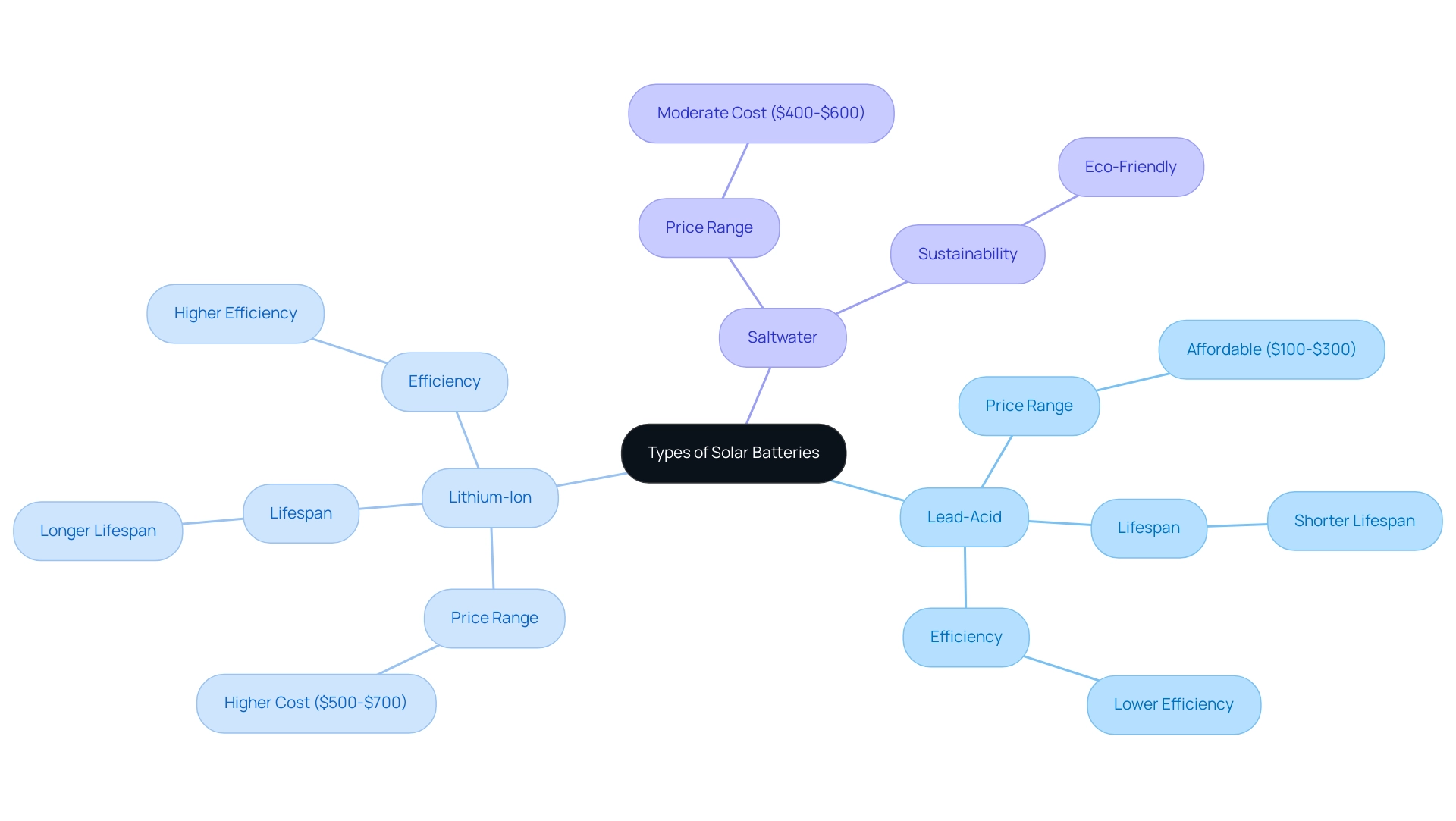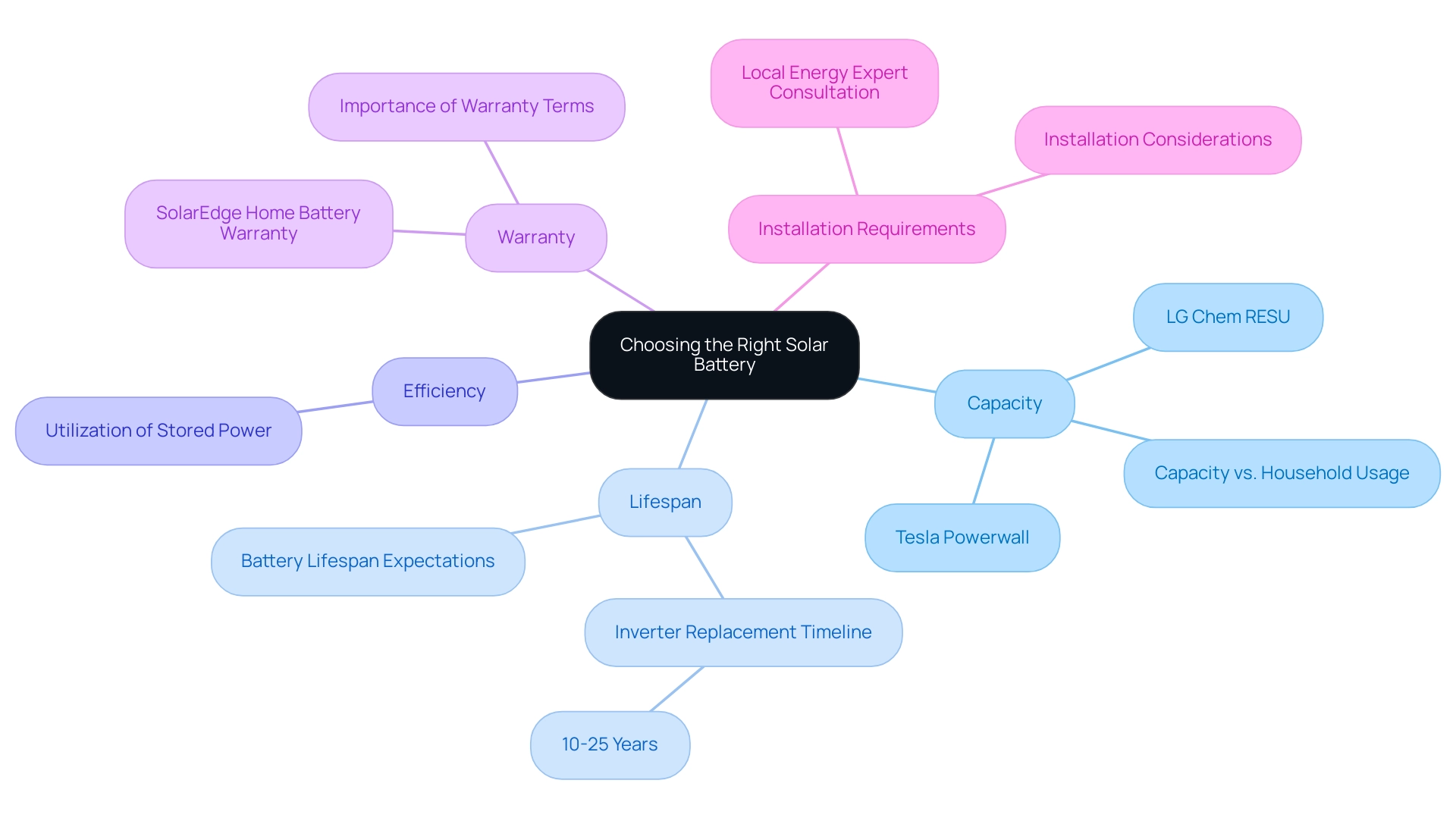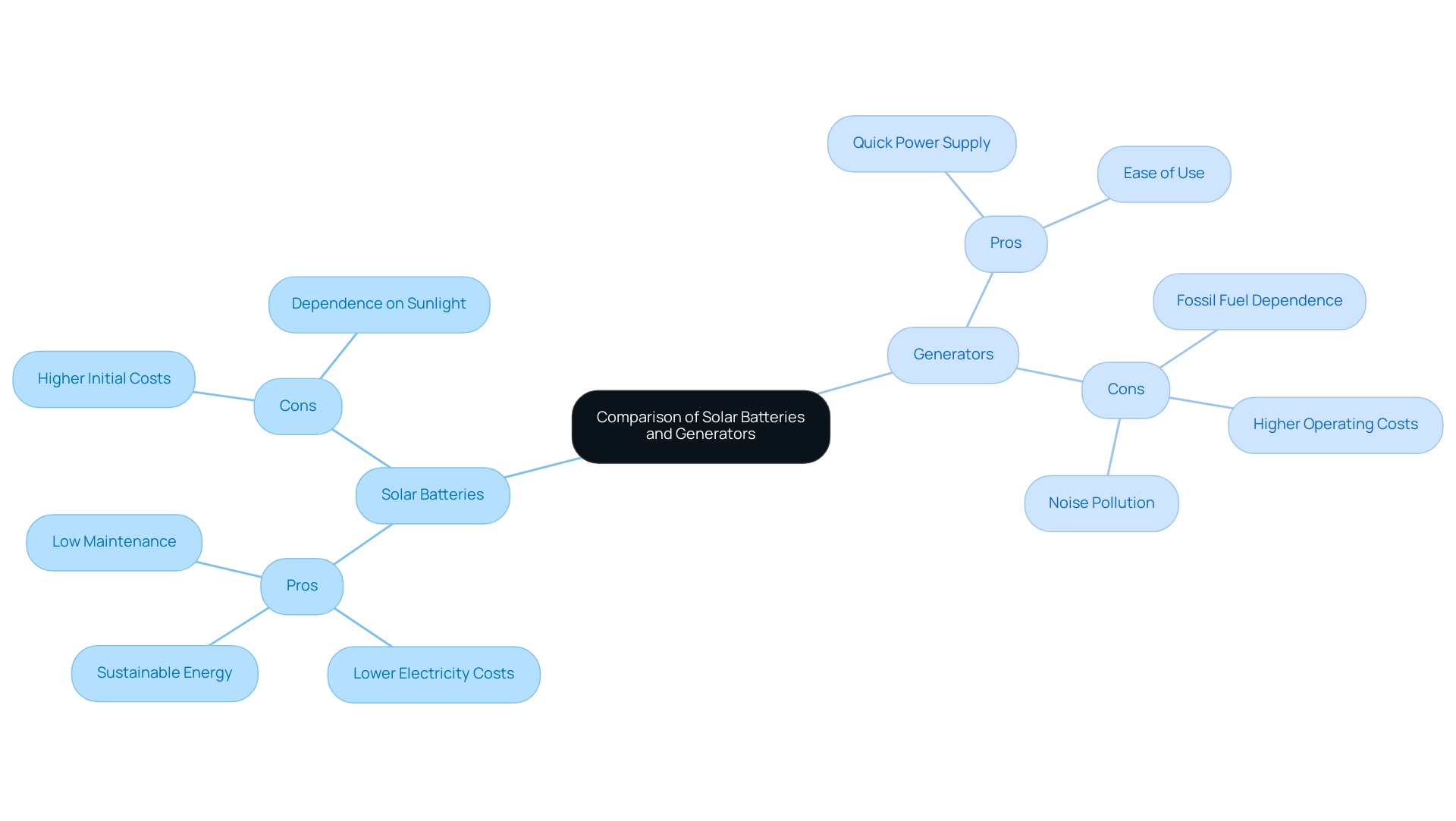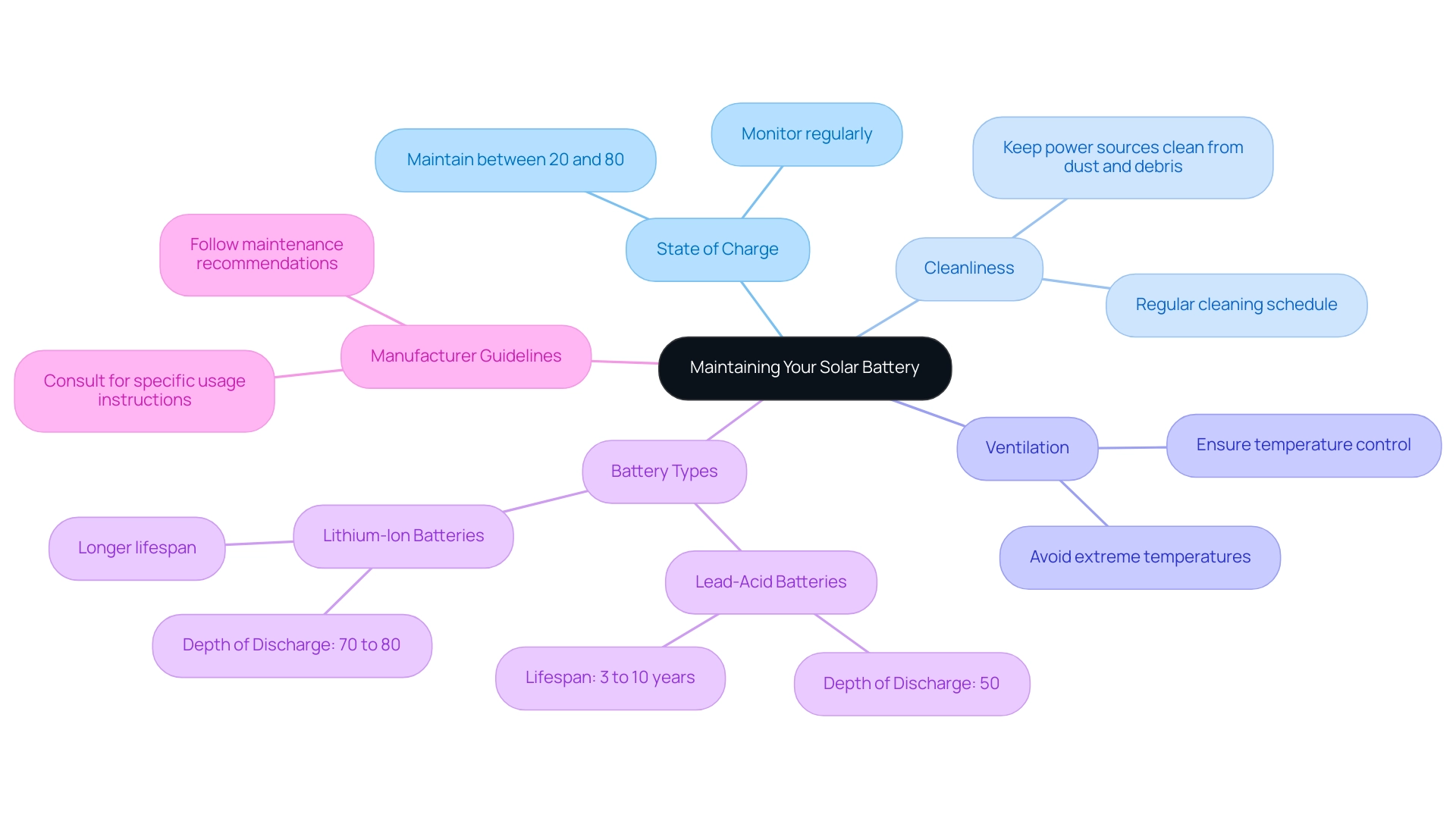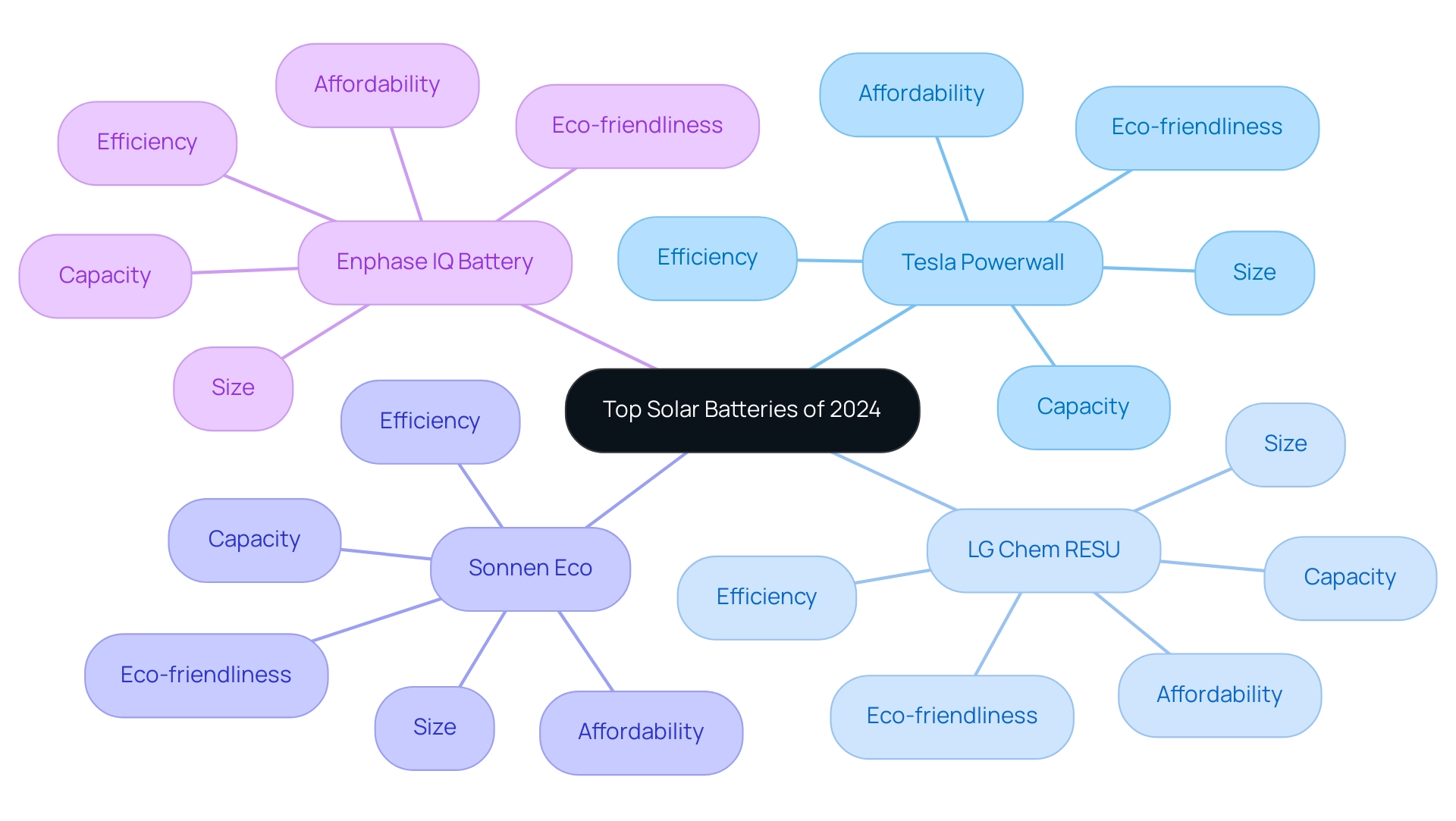Introduction
Navigating the world of solar energy can feel overwhelming, especially when it comes to selecting the right solar battery for a home. With so many options available, understanding the differences between battery types—like Lead-Acid, Lithium-Ion, and Saltwater—can make all the difference in optimizing energy storage and enhancing sustainability.
This guide delves into the key considerations homeowners should keep in mind, from capacity and lifespan to maintenance tips, ensuring that each choice aligns with their unique energy needs. As the renewable energy market continues to evolve, knowing the pros and cons of solar batteries versus traditional generators can empower homeowners to make informed decisions that not only benefit their households but also contribute to a greener future.
Whether exploring the latest models or learning how to maintain existing systems, this article aims to provide the insights necessary for a successful solar journey.
Exploring the Different Types of Solar Batteries
When exploring options for energy storage, homeowners often ask, what is the best solar battery among the three primary types: Lead-Acid, Lithium-Ion, and Saltwater units? Lead-Acid cells have been the traditional choice due to their affordability, typically ranging from $100 to $300 per unit, though they come with limitations like shorter lifespans and lower efficiency. On the other hand, Lithium-Ion cells are increasingly popular thanks to their impressive energy density, longer lifespan, and falling prices, generally between $500 and $700, making them a wise investment for many families.
For those prioritizing sustainability, Saltwater energy storage systems emerge as an eco-friendly alternative, crafted from non-toxic materials, priced around $400 to $600. Each type of battery has its pros and cons; while Lead-Acid batteries may offer lower upfront costs, when considering what is the best solar battery, the longevity of Lithium-Ion batteries could lead to substantial savings in the long run. As the renewable power sector expands—with photovoltaic capacity reaching 100 GW in 2017, marking a 31% increase from the prior year—homeowners need to consider what is the best solar battery to optimize their photovoltaic systems.
The increasing focus on sustainable power storage solutions reflects a market evolution, hinting at an ongoing demand for these technologies. One satisfied homeowner shared, ‘Thank you very much for your cooperation and post-purchase support. We were really happy with the final deliverable, and the takeaways from the report,’ underlining the significance of making informed choices in this dynamic market.
Another customer remarked, ‘The installation process was seamless, and the support from Powercore Electric was exceptional throughout.’ At Powercore Electric, we take pride in offering local expertise, unparalleled craftsmanship, and a customer-first approach, ensuring our community has access to the finest energy solutions customized for their needs.
Key Considerations for Choosing the Right Solar Battery
Selecting the appropriate solar storage system often leads to the consideration of what is the best solar battery, as several crucial elements can greatly influence your power autonomy. First and foremost is capacity, measured in kilowatt-hours, which indicates what is the best solar battery for how much power the storage unit can retain for your household. This is essential, as larger capacities offer more backup energy but usually have a higher price tag.
It’s essential to comprehend what is the best solar battery in terms of how power capacity corresponds with your household consumption and backup power objectives. For instance, many people ask what is the best solar battery, and the Tesla Powerwall is often mentioned due to its robust storage capacity, sleek design, and advanced technology, making it a top choice for many homeowners. When discussing what is the best solar battery, the LG Chem RESU stands out as a notable option, known for its excellent performance and compatibility with various inverters, providing a reliable solution for diverse energy needs.
Similarly, the Sonnen Eco emphasizes sustainable resource management, which raises the question of what is the best solar battery while delivering dependable performance.
Then there’s lifespan—understanding how long a power source lasts before it requires replacement is essential for long-term planning. Recent trends show that different types of solar batteries have varying lifespans, with inverters often needing replacements every 10 to 25 years, which is an important maintenance expectation to consider. Efficiency is another key factor in determining what is the best solar battery, as it affects how much of the stored power you can actually utilize.
For instance, the SolarEdge Home Battery stands out by providing an exceptional warranty, which leads homeowners to consider what is the best solar battery for their storage needs.
As Sarah Drolet, a former industry writer, noted, “The power output of the Powerwall 3 is a significant improvement from previous models, with a continuous power output of 11.5 kW.” This emphasizes the progress in battery technology that can assist in your power independence.
Lastly, when evaluating what is the best solar battery, don’t overlook the importance of warranty terms and installation requirements; these can greatly influence your satisfaction with the system. Engaging with local energy experts can provide tailored advice to help you understand what is the best solar battery that aligns with your unique energy consumption patterns and goals, ensuring you make an informed choice. Additionally, considering the incorporation of virtual energy plant business models can enhance the value of your investment by participating in flexibility markets, which can improve grid stability and efficiency.
For additional help, think about contacting local energy providers in California, who can provide valuable insights and support in choosing the best energy storage solution for your needs.
Solar Batteries vs. Generators: Pros and Cons
Unlocking Solar Power: Essential Guide for Long Beach Renters to Access Eco-Friendly Energy Solutions. When discussing backup energy options, photovoltaic storage systems and generators provide unique benefits that every environmentally aware homeowner in Long Beach should contemplate. Solar storage systems collect and retain power produced by solar panels, offering a sustainable power source that not only lowers electricity costs but also diminishes reliance on the grid.
Most energy storage devices will keep the lights on during a power interruption and can supply essential loads like electrical outlets, lighting, and small appliances. For instance, lithium-ion batteries are known for their high energy density and long lifespan, making them a popular choice among homeowners. In contrast, traditional generators typically rely on fossil fuels, leading to higher operational costs over time and contributing to noise and air pollution.
While generators can quickly supply electricity during outages, they require fuel and regular maintenance, which can be a hassle. Whole home generators are equipped with an automatic transfer switch to start automatically when grid electricity fails, ensuring a seamless transition to backup energy. Moreover, as emphasized in the case study titled ‘Choosing the Right Generator,’ homeowners can benefit from guidelines on selecting a suitable generator based on their energy needs, ensuring that there are appropriate options for various energy requirements.
For instance, if your residence needs 5,000 watts of energy, seek a generator that can manage that load while offering a cushion for peak consumption. As you investigate backup power alternatives, think about the benefits of Tesla home chargers, which enable you to recharge your electric vehicle using renewable energy, and the different government initiatives accessible to assist your shift to renewable energy. Weighing the pros and cons will help you understand how each system aligns with your values and needs, ultimately guiding you to make the best choice for your home.
Maintaining Your Solar Battery: Lifespan and Care Tips
To extend the longevity of your energy storage units, there are various helpful maintenance suggestions to consider. Regularly monitoring the state of charge (SoC) is essential; ideally, it should be maintained between 20% and 80% for optimal performance, as solar energy storage systems are designed to operate effectively within this range. Furthermore, keeping your power sources clean from dust and debris plays a crucial role in maintaining efficiency.
Don’t forget about proper ventilation—ensuring that your power sources are in a temperature-controlled environment can prevent any adverse effects caused by extremes. It’s important to note that lead-acid cells typically have a depth of discharge (DoD) of 50%, while lithium-ion units can range from 70% to 80%. This distinction can influence your maintenance practices, as understanding the limits of each battery type helps in planning charging cycles.
Most manufacturers offer guidelines that can be a treasure trove of information, so be sure to consult these resources for specific usage and maintenance instructions. Engaging with local solar professionals for routine checks can provide additional peace of mind, ensuring your system runs smoothly. Furthermore, as a homeowner in Long Beach seeking to access eco-friendly power solutions, it’s essential to evaluate what is the best solar battery for your options thoroughly.
For example, with proper care, lead-acid cells can last between 3 to 10 years, depending on quality and usage conditions, whereas lithium-ion types often have a longer lifespan. By adhering to these straightforward methods, your storage units can keep supplying your home efficiently for years ahead, aiding your path toward autonomy and sustainability while functioning in harmony with your panels.
Top Solar Batteries of 2024: A Comprehensive Review
In 2024, if you’re searching for high-quality energy storage solutions, you may be asking what is the best solar battery among the choices that really stand out. The Tesla Powerwall remains a frontrunner, celebrated for its impressive capacity and efficiency, making it a favorite among many homeowners. It’s especially effective when combined with Tesla home chargers, which optimize power usage from solar panels, enhancing overall efficiency.
If you’re tight on space but still want stellar performance, the LG Chem RESU is a compact powerhouse that’s perfect for smaller residences. For individuals who value eco-friendliness, the Sonnen Eco power source stands out because of its sustainable materials and outstanding resource management features. Each of these power sources has garnered positive feedback from users, which raises the question of what is the best solar battery in terms of reliability and effectiveness.
Remember, if each lithium-ion cell supplies 7 kWh, you would require five units to satisfy daily power requirements effectively. As one specialist accurately remarked, ‘This calculation aids in sizing the storage bank suitably to fulfill daily power requirements efficiently,’ highlighting the significance of selecting the correct system for your residence. Additionally, the Enphase IQ Battery offers a compelling case with its affordability and extensive customer support options, despite lower performance scores.
With advancements in lithium power cell technology showcasing higher efficiency (85-95%), longer lifespans (10 years warranty), and faster charging, investing in renewable energy storage has never been more appealing. Furthermore, government programs can provide financial support for both solar batteries and home chargers, while top-notch solar cleaning services ensure your panels perform at their best!
Conclusion
Understanding the landscape of solar batteries is crucial for homeowners looking to optimize their energy storage and contribute to a sustainable future. The article has explored the three primary types of solar batteries—Lead-Acid, Lithium-Ion, and Saltwater—each with unique advantages and considerations. From the affordability and accessibility of Lead-Acid batteries to the efficiency and longevity of Lithium-Ion options, it’s clear that the right choice depends on individual energy needs and budget.
Key factors such as capacity, lifespan, and maintenance play a significant role in selecting the ideal battery. Homeowners are encouraged to assess their energy consumption patterns and backup power goals to make informed decisions. The comparison between solar batteries and traditional generators highlights the benefits of renewable energy sources, emphasizing lower operational costs and reduced environmental impact.
Finally, proper maintenance is essential for maximizing the lifespan and efficiency of solar batteries. Simple practices, like monitoring the state of charge and ensuring adequate ventilation, can help keep systems running smoothly. By staying informed and engaged with local solar experts, homeowners can confidently navigate their solar journey, ensuring their investments not only enhance their home’s energy independence but also support a greener planet for future generations.



